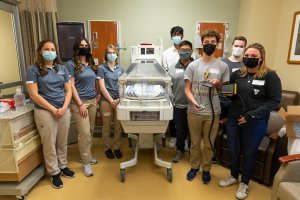Collaborating Across Campus

In Valpo’s Colleges of Nursing and Health Professions and Engineering, collaboration is key to the educational experience of students and professional development of faculty members.
Recently, faculty within the two Colleges worked together to research, design, and implement a sensor that records lights and sounds in isolettes — clear, enclosed cribs that maintain a warm environment for new babies and isolate them from germs — in the newborn intensive care unit (NICU).
Christina Cavinder ’14 DNP, RN, CPNP-PC, associate professor of nursing, conducts research pertaining to methylation levels in babies born prematurely. These levels can spike when babies face stressful situations and can lead to complications later in life including post-traumatic stress disorder (PTSD). To reduce these increases, research suggested to decrease pain in newborns, increase parental contact, and decrease stressful stimuli.
“I wanted to find a way to monitor what babies experience in an isolette,” Professor Cavinder says. “Before we can decrease stressful stimuli, we first have to determine what can be considered stressful.”
In order to answer this question, she contacted Reva Johnson ’09, Ph.D., associate professor of mechanical engineering and bioengineering, and her senior design class.
“The design team interviewed Professor Cavinder, nursing students, hospital engineers, and local nurses to better understand the problem at hand and how they could address it,” Professor Johnson says.
After the initial interviews, the engineering students began to design a system that would be placed in an isolette to monitor different stimuli such as noise levels and the color and intensity of lights.
“Their first proposal was not going to work due to space constraints, but it was a great opportunity for my students to realize they weren’t on the right track and needed to try again,” Professor Johnson says. “The ability to recognize a failed design and understand what needs to change is crucial for an engineer, especially in a clinical setting.”
Close faculty relationships at Valpo give students this opportunity to experiment, fail, and try again, while learning from mistakes they made along the way.
Professors Cavinder and Johnson were also able to share a parental perspective, as both had newborns who spent time in the NICU. They used their own experiences to guide students through the design process and eliminate elements that might be stressful for parents.
The monitoring system was redesigned as a self-contained unit that could be clipped to an IV pole. Once the data were confirmed to be accurate and precise, Professor Cavinder tested it at a local hospital’s NICU.
“The nurses had a lot of fun with it,” Professor Cavinder says. “They played with factors including turning on the maximum heat and humidity settings to see what the monitor would register as stressful.”
While much of the testing response was positive, it also provided an eye-opening experience for the hospital staff.
“When we ran the tests, the levels were in a good range until doors were opened or people talked normally,” Professor Cavinder says. “The nurses were shocked to see how small changes in noise or lighting can be stressful to a premature baby.”
Students in both Colleges received an opportunity to not only conduct research related to their field but have a meaningful impact in their community.
Now that the external stimuli can be monitored, testing will be conducted to evaluate the methylation levels on premature babies. Professor Cavinder will then begin to apply circadian lighting principles she learned during a Valpo Spring Break trip to Altentreptow, Germany, to determine if lighting changes can have a positive effect.
While this stage of the project has been completed, the collaborative work between the Colleges is far from over.
“I love working closely with CONHP faculty and local clinicians,” Professor Johnson says. “My hope is that we can continue to collaborate through the senior design program and maintain our mutually beneficial relationship for future students.”
